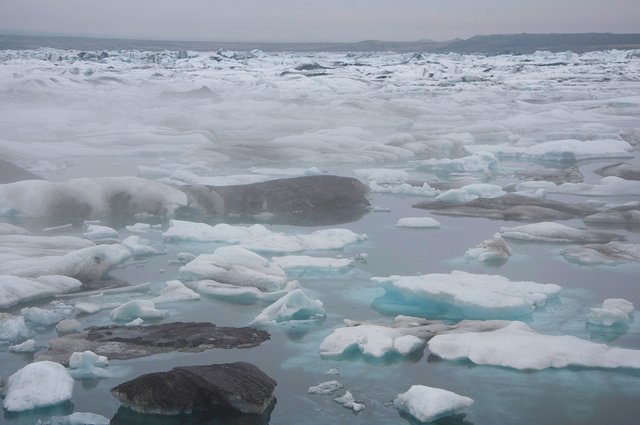Hello Steemians. Today's nature fix is pretty cool (pun intended): Icebergs.

I'll be sharing a few photos from our iceberg hunting and they were all taken in Iceland and Alaska; seems to be fitting places to look, no? On a previous Daily Nature Fix post (read it HERE), I talked about how seeing a glacier was near the top of my bucket list. What I didn't mention there, but should have, was that seeing icebergs in person was on that list as well. The two kind of go hand-in-hand, I guess, so I didn't really think about it. Anyway, both of these items were knocked off that list when we saw the Mendenhall Glacier outside of Juneau, AK... and the icebergs it was calving were doozies!

^^^My first ever iceberg sighting. Notice the kayakers for size comparison.
Now, these weren't exactly the Titanic-killing monsters like my post title might imply, but they were BIG. Some were easily the size of houses and tractor trailers. That's just what you could see above the water too. Keep in mind that 90% of an iceberg's mass is below the water surface. Interesting fact: the largest iceberg ever recorded was Iceberg B-15. It calved from a massive ice shelf in Antarctica in the early 2000's and was over 4,200 square miles in size. It was bigger than the entire island of Jamaica!
About two years after our trip to Alaska, we got another good dose of icebergs in Iceland. In the south east part of the country, there are several tongues of the massive Vatnajökull glacier. We jumped on route 1 in Reykjavik and started the 5ish hour drive that way. Toward the end of the drive, we started to see some glacial activity in the distance, so we knew we were close. It was a dreary, overcast, and foggy day but I spotted an approaching pull off with some guide lines running along a small trail that went over the roadside ridge. We climbed up and there it was: Jökulsárlón.

^^^Our first glimpse of Jökulsárlón.
Jökulsárlón is a pretty massive glacial lagoon at the face of the Breiðamerkurjökull tongue of the Vatnajökull glacier. The lagoon is about 7 square miles and it empties right into the Atlantic Ocean. Aside from the massive amount of icebergs, the thing that really jumped out was the awesome blue water that the icebergs were suspended in. Full disclosure: I have a huge hard-on for blue water. It's one of my most favorite things in nature. Before I started traveling, I spent 25 years of my life in Pennsylvania and the only blue water I ever saw was in a swimming pool. Don't get me wrong, we have a lot of cool nature and woodlands in PA, but blue water is just not to be found. Anyway, we got to this spot pretty late in the day so we got back in the car and continued heading east to our hotel for the night. The next morning, we were bound to check out this lagoon up close!

^^^A congregation of icebergs several hundred feet long.
The next day we headed back out to the parking area of Jökulsárlón and decided to take a boat tour of the lagoon. Before long we boarded an amphibious LARC-V cargo vehicle and drove in to the water. What a great experience it was. Both the color and the patterns of the icebergs were something I wasn't expecting. The first time I saw icebergs in Alaska, they didn't have the stripes of black like these ones did. The years of volcano eruptions over Iceland's history left layers upon layers of pitch black ash through the glacier. When chunks of ice would break free, they'd float in the water at all different angles and would make some really cool designs when the ice chunks all group together.

^^^An example of the volcanic ash striping. The glacier is visible to the far right of this photo.
The color was the other eye-catcher. Like I mentioned above, I love blue. Blue is a color you just don't see much in nature (aside from the sky). You certainly don't see it much in Pennsylvania. Hence, I get excited anytime I see a bluebird or a bluejay, or a blue tropical fish, or a blue insect. The blue of these icebergs was amazing. Its actually tells their age a bit too. Older glaciers spend hundreds and hundreds of years getting snow and ice accumulated on them. That's heavy stuff. All of that pressure forces out the billions of tiny air pockets trapped by snowfall and sleet, etc. You end up with a lot more pure ice and that absorbs more light from the sun, reflecting back just the blue wavelengths. Younger glaciers/icebergs have a lot more fresh snow and frost and air entrained in it and that reflects back all of the colors, causing them to be white.

^^^Oh them blues... they get me every time.
Thanks for reading and we'll see you tomorrow. - Adam
***Daily Nature Fix is a daily blog showcasing the natural world. It is all original content using photos, stories, and experiences from my own travels.***

Follow me to see get your #dailynaturefix!
Nice iceberg shots!
Downvoting a post can decrease pending rewards and make it less visible. Common reasons:
Submit
Thank you for the kudos, sir!
Downvoting a post can decrease pending rewards and make it less visible. Common reasons:
Submit